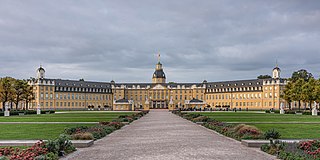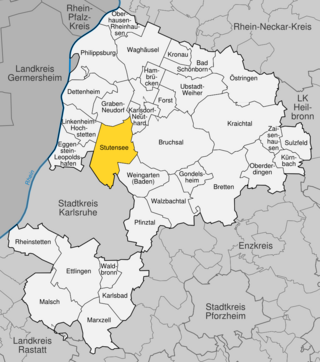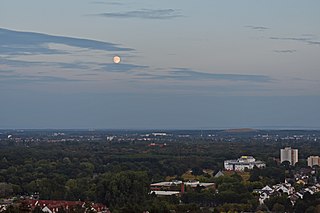
Karlsruhe is the third-largest city of the German state of Baden-Württemberg, after its capital Stuttgart and Mannheim, and the 22nd-largest city in the nation, with 308,436 inhabitants. It is also a former capital of Baden, a historic region named after Hohenbaden Castle in the city of Baden-Baden. Located on the right bank of the Rhine near the French border, between the Mannheim-Ludwigshafen conurbation to the north and Strasbourg to the south, Karlsruhe is Germany's legal center, being home to the Federal Constitutional Court, the Federal Court of Justice and the Public Prosecutor General.

Heilbronn is a city in northern Baden-Württemberg, Germany, surrounded by Heilbronn District.

Stutensee is a town in northern Karlsruhe district in Baden-Württemberg, Germany.

Dreieich is a town in the Offenbach district in the Regierungsbezirk of Darmstadt in Hessen, Germany. The town is part of the Frankfurt Rhein-Main urban area and is located roughly 10 km (6.2 mi) south of downtown Frankfurt am Main. With a population of more than 40,000 it is the district’s second largest town.

Langen is a town of roughly 39,000 in the Offenbach district in the Regierungsbezirk of Darmstadt in Hesse, Germany. The town is between Darmstadt and Frankfurt am Main and part of the Frankfurt Rhein-Main urban area. Langen is headquarters to Deutsche Flugsicherung, and is also home to the Paul-Ehrlich-Institut, a Federal institute for the evaluation and supervision of sera and vaccines in Germany.

Karlsruhe Hauptbahnhof is a railway station in the German city of Karlsruhe. The station is classified as a Category 1 station, as it is a major hub where several railways connect.

The Karlsruhe Stadtbahn is a German tram-train system combining tram lines in the city of Karlsruhe with railway lines in the surrounding countryside, serving the entire region of the middle upper Rhine valley and creating connections to neighbouring regions. The Stadtbahn combines an efficient urban railway in the city with an S-Bahn, overcoming the boundary between trams and trains. Its logo does not include the green and white S-Bahn symbol used in other German suburban rail systems and the symbol is only used at stops and stations outside the inner-city tram-operation area.

Albtal-Verkehrs-Gesellschaft is a railway company owned by the city of Karlsruhe that operates rail and bus services in the Karlsruhe area, southwest Germany. It is both a train operating company, as well as an infrastructure operator.

The Rhine Railway is a railway line in the German state of Baden-Württemberg, running from Mannheim via Karlsruhe to Rastatt, partly built as a strategic railway and formerly continuing to Haguenau in Alsace, now in France.

The Enz Valley Railway is a 23.6 km (14.7 mi) long railway line in the northern part of the Black Forest in the German state of Baden-Württemberg. The line runs from Pforzheim to Bad Wildbad and for its course runs close to the River Enz.

Bergen-Enkheim is a borough (Ortsbezirk) of Frankfurt am Main, Germany.

The Hardt Railway is a railway line in the Karlsruhe region of Germany. Originally built as part of the Rhine Railway, a through main line, it now forms a branch line from Karlsruhe to Hochstetten. The line runs along the western edge of the forest of Hardtwald, from which it takes its name.

Karlsruhe-Durlach station is the second largest station in the city of Karlsruhe in the German state of Baden-Württemberg after Karlsruhe Hauptbahnhof. It is used by services of the Karlsruhe Stadtbahn and the Rhine-Neckar S-Bahn, regular regional services and occasional long-distance trains.

The Karlsruhe tramway network is a network of tramways forming part of the public transport system in Karlsruhe, a city in the federal state of Baden-Württemberg, Germany.
The Leipzig-Plagwitz–Leipzig Miltitzer Allee railway is a two-track electrified main-line in the German state of Saxony. It runs from Leipzig-Plagwitz to Leipzig-Grünau and is integrated into the network of the S-Bahn Mitteldeutschland. However, there were no services on the line from the end of April 2011 until 14 December 2013 due to a reduction in funding for public transport.

Rüppurr is a district in the south of Karlsruhe, Baden-Württemberg, Germany, with around 11,000 inhabitants. The district borders on the neighboring town of Ettlingen and is considered to be one of the more affluent residential areas in Karlsruhe.

Palmbach is the smallest district of the Baden-Württemberg city of Karlsruhe. The Waldensian town of Palmbach is located on the southeastern edge of the urban area and was incorporated into the city of Karlsruhe on January 1, 1975. Naturally, it is located in the northern Black Forest, is the highest residential area in Karlsruhe and has been part of the Central/North Black Forest Nature Park since January 2021.

Oststadt is the eastern district of Karlsruhe. It is located east of the Durlacher Tor, which borders the city center, and borders the Durlach district to the east.

Grünau [ɡʁyˈnaʊ̯] is a large housing estate in the western part of Leipzig, Germany, designed in the 1970s and 1980s. It dominates the Stadtbezirk Leipzig-West. In its short history Grünau was at times the most populated district of Leipzig with a maximum of 85,000 inhabitants (1989).

The Oberwald in Karlsruhe, Germany, is an urban park-like forest and a Landschaftsschutzgebiet. It is known primarily for its freely accessible animal park, the Tierpark Oberwald, which is part of the Karlsruhe Zoo.






















